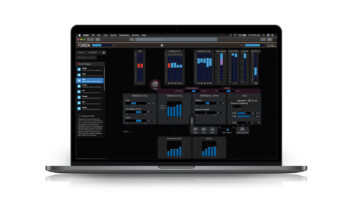Mic processing & On-air processing
May 1, 2007 12:00 PM, By Doug Irwin, CSRE
Periodically, it’s good to review the current state of audio processing technology. The manufacturers that we are all familiar with, and some that are new to the business, are rapidly meeting our needs with respect to data-reduced (or simply low bit rate) transmission pathways. In addition to those changes in functionality there are more and more examples of updated input and output protocols.
There is nothing new about the technique of adding separate audio processors for studio microphones. What started off as a way to give jocks a bit of boost in certain characteristics of their voices (most notably low frequency equalization) has evolved slowly over the years and now includes not only EQ, but also compression, gating and downward expansion. Other changes in broadcast technology are reflected in modern microphone processors as well, such as the addition of digital outputs and word-clock inputs.
Aphex has recently introduced the 230, the latest in its long line of mic preamp/processor boxes. This is a single channel, 1RU device that has a vacuum tube (12AT7) mic preamp, parametric EQ, compression, gating, de-essing, +4dBu and -10dBV analog outputs, along with digital outputs (AES, S/PDIF and optical formats) with 24-bit resolution (96kHz sample rate).

Mic processors have evolved into highly configurable devices, such as the Aphex 230, the dual-channel Air Tools 6200, or the Yellowtec VIP/Digital with built-in card reader.
Airtools by Symetrix offers the 6200 digital voice processor. This is a two-channel, 1RU device containing two processing chains that will work at mic or line level, in a stereo mode or independently. Standard processing features, such as high-pass and low-pass filters, compressor/limiter, four-band parametric EQ and downward expansion are included. Processing settings are configured from the front panel or from 6200 Designer, a Windows application. After the unit has been programmed, real-time control of the device is available by PC via RS-232, USB or Ethernet. Symetrix also offers the 528E.
TC Electronic manufactures the Gold Channel, a 1RU, two-channel mic preamp and audio processor. The mic preamp in this unit is immediately followed by an A/D converter, which allows for all processing functions, such as compression, expansion, equalization and de-essing to be done in the digital domain. The user can save settings in any one of 100 memory locations, and the unit comes with 100 factory presets as well. Aside from balanced analog outputs, there are digital outputs (AES, S/PDIF and optical (TOS-link) formats).
Focusrite offers the VMPRO channel strip, a 2RU single channel mic preamp and processor. This unit boasts a (solid state) class-A mic pre, along with the following processor sections available on the front panel: expander; vintage harmonics; compressor; tube sound; and voice-optimized EQ. Analog outputs are standard, digital outputs are optional.
DBX has been in the processing business for years and has recently manufactured the 376 (with digital outputs). This 1RU mic preamp/processor begins with a vacuum tube microphone preamp followed by a (semi-parametric) EQ, compressor and de-esser. The digital output has selectable sample rates (44.1-, 48-, 88.2- or 96kHz) and adjustable word length (16-, 20- or 24-bit) in the AES or S/PDIF formats. Word clock input and output is via BNC connectors.
Aircorp offers the 500PH, which is a single channel, 1RU mic preamp and processor with three channels of graphic EQ; phase rotation; compression and expansion; an insert point; de-essing; mic and line level outs, and a headphone out that allows the engineer to set up the unit without having it actually on air.
Yellowtec manufactures the VIP/Digital, a 1RU device that stores its settings to Smartcards so each user can establish his own presets. It includes mic and line inputs, analog and AES3 inputs, 24-bit A/D-D/A converters, 100 internal presets, an FFT-based de-esser and reverb.
Mic processing & On-air processing
May 1, 2007 12:00 PM, By Doug Irwin, CSRE
Processing for your content
We are content providers now, as you may recall. In fact, about the only aspect of our content provision that is increasing is the use of streaming audio. For this reason I suggest avoiding grabbing an old processor off of the shelf in the engineering shop (or worse yet, bringing one back from the transmitter) for processing a streaming audio feed. Even though the reasons for processing the streaming audio are basically the same as that for over-the-air signals, the methodology is different in some key respects. For example, clipping is the most basic way to build loudness in an analog system. The reason is that it is easy to get away with, in the sense that distortion products are often either super-audible, or so fleeting in nature that they’re almost impossible to notice.

Specialized processors fit specific needs, such as accurate leveling with the Tranlantech Ariane Sequel or low bit-rate processing with the Neural Audio Neustar 4.0.
It’s not that simple in a data-reduced system; you do not want a streaming encoder trying to allocate bits to distortion products. That results in fewer bits left over for what you really want to hear. Throw that idea out.
Another way we have built loudness in our old-fashioned analog systems is by the use of HF limiting. The digital systems we are now using are flat � that is, no emphasis � so the HF limiter idea is of no value there either. And finally, we all know that our analog systems don’t necessarily have a rigid brick wall limit through which they can’t pass � unlike digital systems, which are all burdened with their 0dBFS limits that cannot be exceeded.
Therefore, the three key aspects of audio processing for data-reduced paths (whether it is HD Radio or streaming audio) that remain in common with established analog techniques are wide-band AGC, multi-band AGC and peak limiting. Modern processors often use look-ahead limiters as opposed to the peak limiter (fast attack and fast release) that most of us have grown up with. So what’s available?
Translantech offers the Ariane Sequel digital audio leveler. This unit uses a digital signal path all the way through. It includes a sum and difference mode with an independent or stereo linked mode available; output peak limiting; sample rates of 32kHz, 44.1kHz or 48kHz (syncs to input); eight user presets; TCP or RS-232 remote control; and peak and RMS readings on input and output sides.

Thanks to DSP, processors are more compact but pack a great deal of processing power, such as the Orban 6300, the Omnia One and the Vorsis HD-P3.
Neural Audio offers the Neustar 4.0, a single rack unit audio processor built specifically for low bit-rate applications such as HD Radio, streaming audio and podcast encoding. Make adjustments from the front panel or via TCP/IP and a browser interface. The unit features balanced analog inputs and outputs, AES3 (32kHz to 96kHz sample rate) inputs and outputs, and word clock in/out.
Omnia has recently introduced a processor made specifically for data-reduced transmission paths: the Omnia One. This processor features four bands of AGC and four bands of limiting, AES3 inputs and outputs with sample rates from 32kHz to 96kHz; RS-232, GPIO and Ethernet ports for remote control.
Orban’s 6300 is a 1RU audio processor that can be used in a number of applications, including HD Radio or streaming audio. It includes a stereo enhancer, wideband AGC, equalizer, a multi-band compressor/limiter and two (stereo) look-ahead limiters available via one stereo analog output and two AES outputs. It also includes a low delay (about 5ms) talent headphone output.
Broadcast Warehouse offers the DSP Xtra, designed for processing audio for FM, HD Radio and streaming audio. It includes the Ariane leveler, multi-band limiting and multi-band look-ahead limiting. Adjustments are carried out from the front panel, or via USB, serial or Ethernet. The AES3 input will sync with any sample rate between 32kHz and 96kHz. The unit features a built-in stereo generator as well.
Wheatstone now offers the Vorsis HDP3, a 1RU audio processor with built-in three-band AGC, parametric EQ, de-esser, downward expander and peak limiter. The unit has a built-in IBOC delay. Adjustments are made via the front panel, via local computer control or via Ethernet.
Linear Acoustic recently introduced the Aeromax HDFM, an all-in-one processor for FM, MPS (HD1) and SPS (HD2). It features an AGC, five-band compression and look-ahead limiting, an HD Radio-delay function built-in, an AES3 input for sample rates between 32kHz and 96kHz that locks to incoming signal or word clock input, and RS-422/485 or Ethernet communication. A stereo generator is optional.
Inovonics manufactures the Omega FM, an FM processor and stereo generator. This 2RU device relies on a Pentium-class microprocessor to do all the processing and multiplexing functions. Sports analog and digital inputs, composite and AES outputs with low-latency making this product suitable for headphone monitoring purposes.
Audio processing is one province of the field of broadcasting that remains solidly in the hands of the engineer at a radio station. It’s wise to keep up on the latest trends in that art. I also happen to believe it is imperative that we, as broadcasters, do everything we can to keep our leadership position in the dissemination of content � whether in the methods practiced for 80 years or the brand new methods via HD Radio or the Internet.
Irwin is the chief engineer of WKTU-FM, New York City.
Resource Guide
Manufacturers of on-air and microphone processors.
On-airMicAphex Systems
818-767-2929
www.aphex.comAircorp
972-304-0455
www.aircorp.bizBroadcast Technology
719-336-3902
www.broadcasttech.comAphex Systems
818-767-2929
www.aphex.comBroadcast Warehouse
888-866-1671
www.broadcastwarehouse.comBehringer
877-672-0816
www.behringer.comCRL
800-535-7648
www.crlsystems.comCrane Song Ltd
715-398-3627
www.cranesong.comHarris
800-622-0022
www.broadcast.harris.comDBX Professional Products
801-568-7660
www.dbxpro.comInovonics
800-733-0552
www.inovon.comFocusrite Audio Engineering
516-249-1399
www.focusrite.comLinear Acoustic
888-292-3117
www.linearacoustic.comGreat River Electronics
651-455-1846
www.greatriverelectronics.comNeural Audio
425-814-3200
www.neuralaudio.comIDT Impact Development
+33 472 18 19 20
www.idt-fr.comOmnia Audio
216-241-3343
www.omniaaudio.comJoemeek/PMI Audio
877-563-6335
www.joemeek.com; www.pmiaudio.comOrban
510-351-3500
www.orban.comLA Audio
+44 20 8418 0778
www.laaudio.co.ukTC Electronic
818-665-4900
www.tcelectronic.comMackie
800-898-3211
www.mackie.comTranslantech Sound
212-222-0330
www.translantech.comMarshall Electronics
800-800-6608
www.mxlmics.comVorsis
252-638-7000
www.vorsis.comOmnia Audio
216-241-3343
www.omniaaudio.comWaves
865-546-6115
www.waves.comPhoenix Audio
+44 1438 812014
www.phoenixaudio.net � Presonus Audio Electronics
800-750-0323
www.presonus.com � Prism Sound
973-983-9577
www.prismsound.com � Studio Projects
877-563-6335
www.studioprojects.com � Symetrix/Air Tools
425-787-3222
www.symetrixaudio.com � TC Electronic
818-665-4900
www.tcelectronic.com � Thum + Mahr/Yellowtec
+49 2173 967 336
www.yellowtec.com � True Systems
520- 721-2735
www.micpreamp.com � Vorsis
252-638-7000
www.vorsis.com












